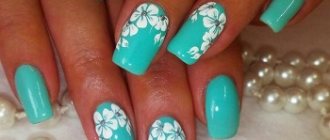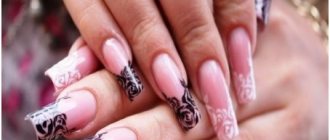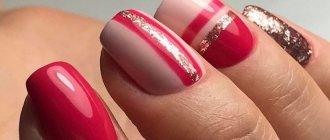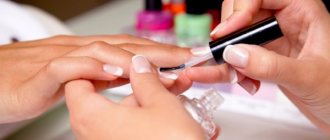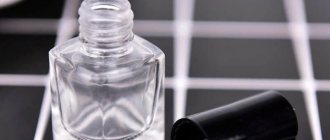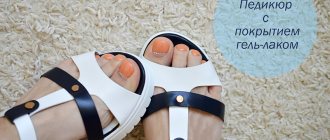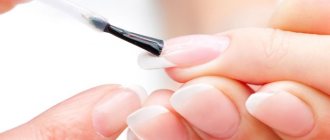Recently I came across such a request as gel polish extensions, and I was very surprised: did I really miss something and technology has stepped forward so much that it has become possible to extend artificial nails with gel polish? But as it turned out, such confusion of concepts arises among many beginners who want to do extensions at home, but at the same time save on materials by buying gel polish instead of gel. Therefore, I decided to devote this article to debriefing, what can be done and with what materials, and what cannot be done!
Price and benefit
The price certainly varies. Gel polish is cheaper, since the cost of materials and labor costs for implementation are different.
But what is more profitable in the end is another question. Gel polish, if it begins to come off, cannot be corrected. You need to remove it, while paying for removal, and then apply a new coating. It is almost impossible to fix one nail, since they will be completely different in appearance.
But a damaged nail extension can be corrected individually, and at the same time without any problems adjusting the overall look into a single ensemble and even changing the design. After all, these nails are not afraid of sawdust and surface polishing.
Therefore, extensions are still more profitable if you wear artificial nails on a regular basis.
Extensions with gel polish base
On the Internet you can find examples and even videos of nail extensions using a gel polish base instead of a base gel. Yes, no one forbade experimenting, but there are a lot of BUTs here:
- This is only a home option, as it does not provide any guarantee of wear. It is better for masters not to sacrifice their reputation by offering such services to clients. And you won’t be able to save much on this.
- You can only increase a small length in this way - up to 5 millimeters.
- You'll have to tinker with selecting a base. It should be thick in order to form at least some volume in the apex area, and rigid so as not to break at the first opportunity. You can determine the hardness of the base by applying it to a plastic bag or something similar and polymerizing it. After this, separate the base from the bag and bend it. If it breaks, it means it is rigid, if it bends, it means it is flexible.
A little life hack if you decide to make your extensions a base for gel polish: add a little acrylic powder to it - this will make the material stronger.
What is the difference between gel polish and nail extensions?
Don't be surprised if this question seems stupid to you; it often comes up among beginners. The main difference is that with extensions we lengthen the nail bed, and with gel polish we simply give it color and make a design. Gel polish can be used after extensions for a color coating.
The application technologies and the materials used for this differ accordingly. A list of everything you need can be easily found on the Internet by asking the question “starter kit for gel polish” or extensions. Stores often sell ready-made kits assembled using technology.
But they are similar in that they stay on the nails for almost the same time - up to 4 weeks, then correction is required.
Which is better: gel polish or extensions?
The last question that we will discuss here is what is better for nails: gel polish coating or extensions. My answer is that this is a matter of preference rather than quality, as both options showed good wear when applied correctly. If you need to choose one thing, I can recommend focusing on the following:
- Do you want to quickly lengthen your nails? There is definitely a build-up here. But even under gel polish, nails break less: it has a kind of strengthening effect, and growing your nails under a long-term coating is easier, but longer.
- If naturalness is important to you without additional volume and weight, then the choice is gel polish. Although modern modeling materials do not give heaviness at all and, if used correctly, volume too.
- If you choose what is best for home use yourself, then it will be easier, faster and cheaper to make gel polish.
- If you want to become a sought-after manicurist, you will have to master all the technologies, starting with the basics of manicure.
These are simple recommendations from me personally. I hope that the article helped you dot all the i’s and decide what you need. Well, on my blog you will find a lot more interesting things about manicure and everything connected with it. Drop by sometimes, I'll be glad to meet you ;)
Harmfulness of materials
If we talk about harmfulness, then chemistry is this and that. Another question is that its effect on the body in such quantities is insignificant for the salon client. But for a master who does this professionally, of course there is a difference.
Gel polish, when applied, does not have a lot of dust from sawdust, as with extension technology. And dust, as you know, is a bad thing. But, if you follow safety precautions and use a respirator during the procedure, then there is no difference in harm and there cannot be.
What common
These two procedures are identical , and practically the same materials and tools are used. Before applying color coating or performing extensions, a hygienic manicure is required. When performed, the cuticle is processed and removed, the length is adjusted and filed.
Manicure is done in both cases and is done in several stages:
- Applying primer to the nail.
- The next stage is using the base.
- After drying, the base layer is covered with the selected color, and when building up, it is coated with gel.
- The final stage is applying the top.
To create a long-lasting manicure, an LED UV or ice lamp is used to dry each layer. When contacting water and cleaning products, it is better to wear gloves.
When extensions are made, the length will interfere with homework. If even a small crack accidentally appears, it is better to immediately contact a specialist so that he can repair or redo the manicure.
The methods differ:
- The time it takes to complete the procedure . Creating artificial nails takes longer than a manicure with gel polish. coating. The extension takes 3-4 hours, not every girl will spend the allotted time. Gel polish is done much faster.
- Gel polish strengthens and does not damage the nail plate . When building up, the top layer of the plate is cut off, causing it to become thinner and weaker.
- about 10-20 minutes to remove the gel polish ; the extensions can be cut off in up to 1.5 hours .
- The price for extensions is much higher than for regular shellac.
Durability of wear
Gel polish lasts 3 weeks. But this is theoretical... But in practice, the nail grows much faster and after a week and a half, an ugly bald spot forms in place of the cuticle, which is difficult to hide. Even if you cover the top with fresh varnish, a small transition will still be visible. But gel polish can’t tolerate filing; it will simply peel off.
Extended nails last much longer and, when they grow back, you can easily file them at the cuticles and paint them with varnish.
Extended nails last longer, again, theoretically. If you dig the ground with them and open beer bottles with your nails, then you yourself understand...
Nail extensions and gel polish coating
Nail extensions are not done with gel polish - this is the main thing that beginners should know. First, a manicure is performed, then extensions, that is, lengthening of the nail bed, after which a gel polish coating is applied to the artificial nails. Gel polish itself is not capable of creating length, as it has a completely different composition and consistency. Extensions can be made with three types of materials:
- Gel is a viscous material that is laid on top of a nail extended with forms or tips, simulating an artificial coating. It is dried (polymerized) in a special lamp (ultraviolet, LED or hybrid).
- Acrylic powder is a powder that is moistened in a monomer, after which it is laid out in a ball onto the nail with a tip or shape, and forms the length. It hardens quite quickly in air, so you need to work with it at a pace.
- Polygel (combigel, acrygel) - as the name implies, this is a combination of gel and acrylic powder, which makes the gel thicker and more durable. But the polygel still hardens in the lamp.
In order to create length, you can use three types of auxiliary materials:
- Lower forms. These are disposable (paper) or reusable (metal) templates with markings applied to them, which are placed under the nail so that artificial material can be applied on top of them. Read about extensions on forms on this page.

- Tips. Plastic tips that are attached to the nails with glue and cut off with a tip cutter. The step between the natural nail and the tip is cut down and extensions are performed. Read more at this link.
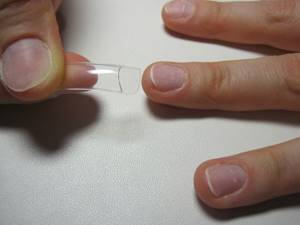
- Upper forms. Popular in polygel extensions. Here the material is laid out directly onto the forms, and then transferred to the nail, dried together with the form in a lamp, after which the tip is removed.
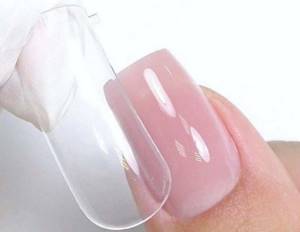
Only after the extension has been completed using one of these materials and the filing has been made to the ideal shape, can you apply a colored gel polish coating with a design. This is such a long procedure!
Modeling or strengthening?
Today, salons offer two main ways to strengthen nails - gel polish and biogel. What are they good for?
Advantages of strengthening compared to extension (modeling):
• the procedure does not involve filing, or it is minimal, which means minimal damage to the nail plate;
• less time is spent on manicure (for comparison: extension lasts about 2 hours, strengthening – 40-60 minutes);
• the strengthening option is ideal if you need to get your nails in order once (for some celebration). In this case, extensions are not recommended due to unnecessary injury to the plate (extensions are more suitable for long-term wear);
• nails look more natural than artificial ones;
• you can grow your nails long, since under the coating they do not break or peel.
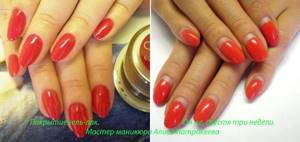
Disadvantages of strengthening compared to extensions:
• more frequent trips to the salon (every two weeks, while extended nails last about a month);
• accordingly, a repeated strengthening procedure will be more expensive than correction of extended nails: you need to do a manicure, remove the material, apply a new one (thus, you pay for three procedures);
• it is not possible to simulate the length of the nail, because the material lies strictly on your nail;
• gel polish and biogel remover is very drying to the skin around the nail (you need to use cuticle cream or oil).
Tips or forms?
The forms (usually paper) are removed after finishing the work. They only help to increase the length, and the material is laid out on the nail itself. Tips are plastic plates that are securely attached to your nail and remain with you until you finish wearing your nails. Alisa Patrakeeva, manicurist: “Tips are suitable for very problematic nails with convex side and front pads, when the nail seems to be sunk into them. Then it is impossible to apply the form, although now there are technologies that allow you to apply the form to such problematic nails. Currently, the technology of extension on forms with lengthening of the nail bed is considered more correct.”
An experienced nail technician can advise which type is suitable for your nail shape and condition. But you can draw some conclusions yourself.
Pros of forms:
• the bond of acrylic and gel with the nail is much stronger than that of the nail with glue and tips;
• when applying extensions using forms, the master has the opportunity to hide some of the shortcomings of natural nails (grooves, growth to the side), and even hands (visual correction of the curvature of the fingers - the nail is extended slightly with an inclination to the side opposite to the curvature; hands with wide nail plates can make it more elegant);
Variety of gel
In beauty salons, there are three main types of gel with different functional loads.
- A gel of transparent consistency is used as the main base layer, since it does not have a bright color. The gel coating masks microcracks on the nails and smoothes the surface.
- Gel sculptor. It contains particles of silk, which give strength to the nail plate.
- Colored biogel. Nail art masters use it to create an original design, covering the nail in stages in two layers. With this manicure, brittleness of the nail plate is eliminated.
Do not neglect manicure , because it is the beauty and health of your hands. Contact first-class specialists in the beauty salon to get high-quality gel nail coating .
Distinctive qualities of shellac
Now let's move on to another popular procedure - shellac. It is simpler, because it does not change the length and structure of the nail. During this procedure, the nail plate is filed to the required size. After this, it undergoes grinding, during which it is necessary to remove the top shiny layer. Without this manipulation, shellac will not have such an attractive, unusual appearance. Then the nail is covered with a special antibacterial disinfectant, a base and two layers of gel polish (although there may be more, the quantity is determined by a specialist). Finally, a top coat is applied. It is important to note that each stage of the procedure is accompanied by drying in a specialized ultraviolet lamp. After this, the sticky layer is removed and nourishing oil is applied to the cuticle.
Read also: Nick Vujicic. Motivation for life
After the procedure, the nails become stronger (the nail plate becomes stronger and denser), and any color, design or pattern will be rich, very beautiful and durable. As mentioned earlier, corrections need to be made regularly.
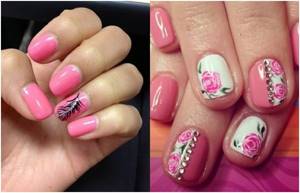
It is worth noting that the procedures for nail extensions and shellac are quite different; they have a number of identical features. For example, after poor quality work by a master, the nail coating may become chipped or cracked. Also, the cause of damage to the work may be a special state of health of the plates - for example, the shade of the nail may become more faded.
How to keep the coating on your nails longer?
- Growing nails cannot be trimmed or trimmed.
- Do not rip off the coating or cut with sharp objects
- Use special removal fluids.
- Try to protect your hands, especially in the first 24 hours after the procedure: avoid contact with hard objects, water procedures, and hot steam.

Following these tips will help keep your manicure smooth, shiny, and chip-free for up to three weeks.
How to remove them?
Both products work almost the same way. To do this, you need cotton sponges, foil, nail polish or shellac remover, and a buff file. To remove shellac easily and without harm, buy a product from the manufacturer. Pour it into a bowl or other enamel container. And we prepare materials for removing varnish. First, cut the cotton sponges in half so that it is convenient to wrap each finger. We also prepare the foil. Dip pieces of cotton wool into the product and squeeze lightly. Place it on your finger, wrap it, and secure it with foil. And keep it for 10-15 minutes. Then remove the compresses one by one. There will still be polish on your nails. We remove it with a stick and lubricate the nails with cuticle oil. If you remove all the sponges at the same time, the product will harden while you treat the adjacent finger. Therefore, do not rush, treat each finger carefully, and only then proceed to the next one.
What is the difference between acrylic and gel nails?
Simply put, acrylic is a mixture of liquid and powder, while gel is a gel. Both of these formulas can be made to conform to the shape of the nail or to lengthen it. So if you want longer or stronger nails, you can choose acrylic or gel extensions. However, gel nails tend to be more flexible and can withstand much more force than acrylic nails.
Now you might be wondering how shellac fits into this picture. Here's what you need to know.



